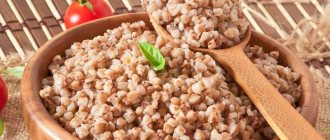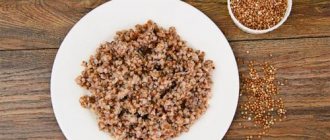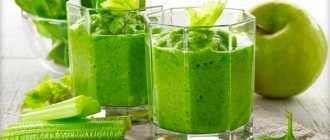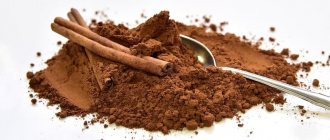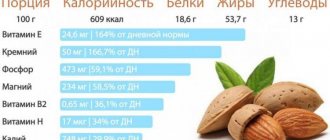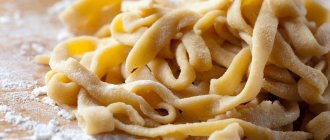- October 16, 2018
- Second courses
- Anna Kirnitskaya
For a variety of culinary recipes using buckwheat, it is necessary to determine the equivalent of cereals. If you have a special measuring cup, then everything is simple, but if you don’t have such a device on the farm, and you need to measure buckwheat now, a spoon or glass will do. You just have to figure out how much cereal will be in such a container. Many housewives are most often interested in the question of how much 100 grams of buckwheat is. Moreover, to complete the picture, we subtract the amount of dry cereal and boiled buckwheat.
Everyone knows that in order to cook buckwheat porridge, you take cereal and water in a ratio of 1:2. 10-12 minutes will be enough for cooking, you need to maintain low heat. After heat treatment, it immediately becomes noticeable that the volume of buckwheat has tripled. So, how much is 100 grams of boiled cereal? Surely most housewives have faced this question. Let’s dot the i’s and find out in more detail how much is 100 grams of buckwheat in tablespoons.
How much is the volume of one hundred grams of buckwheat?
When calculating this value, you should first understand the parameters of density and volumetric mass. Dry buckwheat will have a density of 800 g/l (grams per liter), which means that only 800 grams of product will fit into a liter jar (level with the top of the jar). In this case, the volumetric mass is 1.250 l/kg (liters per kilogram), that is, 1 kilogram of buckwheat will not fit in a liter jar, since it takes up more - 1.250 containers. Considering the features described above, remember that the answer to the question of how much 100 grams of buckwheat is is simple. One hundred grams of buckwheat occupies a volume of 125 milliliters.
How much product does it hold?
How many grams are in a tablespoon of boiled buckwheat? what is its calorie content? how much does 50 grams weigh when boiled?
By correctly measuring the number of grams inside the container, you can prepare complex and accurate recipes. It is recommended to measure using this tool only if you need to take a minimum amount of product in a dish - up to 10 g. Most often it is necessary to measure spices or products when preparing small portions. When preparing recipes for small children, you will also have to use miniature tools.
When taking measurements, the container must be dry and clean. The most accurate results are obtained when using Soviet instruments. Such tools were used to create the table. In addition, the standards for manufacturing large batches make the instruments of those times identical in weight, volume and depth.
Spices
When measuring spices and comparing them with the data indicated inside the table, use a standard, clean and dry instrument. After the spoon is removed from the container with the product, do not forget to shake it lightly.
| № | Name | Amount per teaspoon (indicated in g) |
| 1 | Cinnamon | 8 |
| 2 | Sugar | 8 |
| 3 | Lemon acid | 8 |
| 4 | Poppy | 5 |
| 5 | Potato starch | 6 |
| 6 | Coarse salt | 10 |
| 7 | Fine salt | 7 |
| 8 | Ground pepper | 6 |
If large quantities of the above products are required, it is recommended to use measuring cups or special measuring tools. If there are none, these tables will be useful. It is enough to know how much of the ingredient is needed; we divide this value by the number of grams in a teaspoon and get the number of teaspoons that need to be added to prepare the dish. Using this algorithm, you can use the tool when working with any products, even with a large number of them.
Liquids
When measuring liquids, it is recommended to use measuring glasses and cups. If you need a small volume, using a teaspoon will be more convenient. Similar numbers may be needed when preparing children's portions, decorating finished products, or when there is no other way to weigh ingredients.
| № | Name | Amount per teaspoon (indicated in g) |
| 1 | Honey | 10 |
| 2 | Tomato paste | 10 |
| 3 | Vinegar | 6 |
| 4 | Jam/jam | 5 |
| 5 | Water | 5 |
| 6 | Sour cream | 6 |
| 7 | Oil | 6 |
Liquid products are mainly collected without a slide. This applies to vinegar, water and liquid honey. When scooping up tomato paste or sour cream, you are allowed to make a small mound. You should not scoop up a lot of butter with a spoon, otherwise the figures in the table will be incorrect. To measure the amount of oil described above, you need to pour a full spoon. Only in this case will the measurement be correct.
Bulk
When measuring large quantities of bulk ingredients, it is recommended to use measuring cups. If a small amount is needed, it is better to use a teaspoon. The contents of the spoon must be shaken off for a more accurate measurement. Its dryness is also important. If you don't have a teaspoon, you can use a tablespoon. In this case, you need to mentally divide its volume into 3 parts and fill only one, which corresponds to the amount of ingredients in a teaspoon.
| № | Name | Amount per teaspoon (indicated in g) |
| 1 | Leaf tea | 2 |
| 2 | Cocoa | 9 |
| 3 | Breadcrumbs | 5 |
| 4 | Coffee | 8 |
| 5 | Flour | 8 |
| 6 | Gelatin powder | 5 |
| 7 | Soda | 7 |
| 8 | Dry yeast | 5 |
The information given regarding gelatin is only valid for the powdered ingredient. Gelatin in plates has different data. Ready-made bulk jellies containing gelatin also differ from the quantity described above. The data is correct only when using 100% powdered gelatin before soaking.
As the information described in the article shows, you can measure the amount of any ingredient using a regular teaspoon. The smaller quantities needed, the easier it is to measure. However, if large quantities of ingredients are required, it is recommended to use other, more suitable measurement methods. If this is not possible, a regular teaspoon will do. Skillful use of this tool makes the work of many housewives easier in all kitchens of the world.
Coffee
How much buckwheat is in 1 glass?
Now we have to figure out how many glasses 100 grams of buckwheat are. When understanding this issue, it is worth paying attention to the fact that there are two types of glasses: tea glasses and faceted glasses. Both are characterized by a volume of 250 ml, provided that the container is filled to the top.
The main difference between a faceted glass is a narrow strip located in the upper part, popularly called a rim or a belt. The volume of such a vessel along this very rim is 200 ml. It is important to know about this, since a cut glass is used in cooking more often than a tea glass.
Both glasses will contain 200 grams of cereal. This is provided that the container is filled to the top. Therefore, when figuring out how much 100 grams of buckwheat is, remember that in a glass half-filled there is exactly 100 grams of it.
The power of buckwheat
First of all, buckwheat has high nutritional value. Its composition has a structure of proteins, fats and carbohydrates that is favorable for a healthy body. It is rich in vitamins and minerals, which we so often lack.
Composition according to BZHU
Proteins are the most valuable component of cereals. 100 g of raw product contains 12.6 g of proteins (proteins). There are more essential acids - lysine and methionine - in buckwheat than in all other cereals. Its proteins are easily digestible and serve the growth of muscle rather than fat tissue. 1 gram of protein contains 4 calories.
Fats make up 1/30 of all components of the product: per 100 g of cereal there are only 3.3 g of fat (in boiled buckwheat there is 3 times less). The main part of fats is polyunsaturated, they reduce cholesterol levels, accelerate fat metabolism and thereby promote weight loss. One gram of fat provides the body with 9 calories.
Carbohydrates are the main component of the product - 64 g/100g. But there are no fast carbohydrates - sugar, glucose - in buckwheat. The glycemic index of cereal is 55 units - this means that the absorption of the product occurs slowly, the body consumes energy gradually, without storing excess in the form of fat reserves
Eating buckwheat dishes keeps you feeling full for a long time, which is especially important for those who are struggling with excess weight.
The composition of the BJU depends on the ingredients included in the dish with buckwheat: adding mushrooms, milk or chicken will increase the protein content. Porridge with butter and mushrooms has a lot of fat, and therefore calories; porridge with vegetables has the lowest calorie content.
Table. Nutritional value of dishes with buckwheat (per 100 g of product)
| The product's name | Proteins (g) | Fat (g) | Carbohydrates (g) |
| Buckwheat cooked in water | 3,2 | 0,8 | 17,1 |
| Porridge with added milk | 4,0 | 1,7 | 19,0 |
| Porridge with added butter | 3,6 | 5,7 | 17,8 |
| Porridge with mushrooms | 3,8 | 4,3 | 14,6 |
| Porridge with vegetables | 2,2 | 0,6 | 12,0 |
| Porridge with chicken | 15,0 | 3,8 | 5,7 |
Vitamins
Buckwheat is rich in B vitamins, without which the coordinated functioning of the nervous system is impossible.
It is important that these vitamins work in combination and enhance each other’s effects
100 g of dry cereal contains:
- 20% of the daily value of vitamin B3 (RR);
- 14% riboflavin (B2);
- about 14% pyridoxine (B6);
- 12% thiamine (B1);
- 7.5% folic acid (B9).
All vitamins in this group are important for normalizing weight, since they participate in energy metabolism with the breakdown of carbohydrates and fats.
Minerals
Buckwheat supplies the body with important macro- and microelements.
100 g of dry cereal contains:
- iron (55% of the daily requirement) – an element for the synthesis of red blood cells, which provide oxygen supply to all cells;
- manganese (88% s.n.) - necessary for strengthening bone tissue and increasing immunity;
- copper (66% s.n.) is a component without which it is impossible to transport iron within the body;
- magnesium (61%) and potassium (15%) are the main elements that regulate the functioning of the heart muscle;
- phosphorus (43%) – a substance for strengthening bone tissue.
- selenium (21.5%) is a rare trace element with antibacterial and anti-inflammatory effects.
The chemical composition of buckwheat is 1.5-3 times richer than other cereals, while it has low calorie content and is an indispensable product in dietary nutrition.
How much boiled buckwheat can be made from dry cereal?
To cook buckwheat porridge, take 100 grams of buckwheat kernels and 200 ml of water. It is known that 200 ml of water is equal to 200 g. If the technology for preparing buckwheat porridge is followed, a small amount of water evaporates, and this percentage is about 10-15%. At the same time, the porridge is never fresh. Depending on the recipe, salt, sugar, milk, butter, etc. are added to the cereal. Therefore, depending on the preparation technology and the porridge recipe, from 100 grams of dry product the output is 270-300 grams of boiled porridge.
Here is the answer to this frequently asked question: 100 g of buckwheat - how much boiled cereal is this.
Useful components of buckwheat
Buckwheat contains the following set of vitamins:
- B vitamins necessary to maintain the cardiovascular system;
- PP (nicotinic acid) helps regulate blood sugar and reduce cholesterol;
- E prevents the formation of blood clots, acts as an antioxidant, promotes a beautiful complexion;
- K prevents age-related changes, promotes tissue regeneration.
Buckwheat consists of a large number of microelements.
Cereals are especially rich in iron, so buckwheat porridge is indicated for dietary nutrition for people suffering from anemia.
Selenium contained in buckwheat allows it to be used to prevent cancer and blocks the development of pathological cells at an early stage.
Rutin contained in cereals removes excess fluid from the body.
Potassium (another element of buckwheat) helps improve the functioning of the heart and blood vessels, lower blood pressure, eliminate dizziness and the formation of blood clots.
Buckwheat contains proteins that are easily digested and carbohydrates that are broken down slowly. 100 grams of buckwheat porridge contains only 132 kcal. This is an excellent dish for overweight people.
Such excellent nutritional characteristics may make you want to eat only buckwheat.
How much is 100 grams of boiled buckwheat porridge?
You should already understand that the mass of dry buckwheat groats exceeds the volumetric mass of water. Therefore, the volumetric mass of cooked porridge is higher than that of water and lower than that of dry cereal. This is approximately 1.08 ml/g (milliliters per gram). Taking this into account, 100 grams of boiled buckwheat:
- The volume occupied by the product is 108 milliliters, which is a little more than half a glass.
- This is a little more than 4 tablespoons. You can take heaping spoonfuls to get the required volume - 100 grams of boiled cereal.
Please note that the calorie content of buckwheat is 308 kcal, and the nutritional value of the product is:
- 12.6 g – proteins;
- 3.3 g – fats;
- 57.1 g – carbohydrates.
There is no need to talk much about the benefits of buckwheat; everyone already knows about its properties and qualities. Therefore, be sure to include this product in your weekly diet to feel better, more energetic, and healthier.
We tried to figure out some measurement methods to make it easier for you to understand how much 100 grams of buckwheat is. We hope this information will be useful to you and will definitely come in handy when preparing a variety of dishes from buckwheat - so popular, healthy, medicinal and dietary.
A little history
The cereal is native to the Himalayas, where wild species are still found. In the seventh century, Greek monks began to grow buckwheat. They brought the grain to Kievan Rus, where they began to call it buckwheat. Gradually they began to grow it in the Volga region, Ukraine, and Altai.
The Greeks and Italians themselves called it Turkish grain. In France, Portugal, and Spain, the cereal was called Saracen or Arab grain. Western Slavs (Czechs, Slovaks) call buckwheat toadstool. In England and America, buckwheat is called deer wheat, in Asia - black rice.
Buckwheat is known to many peoples of the world. In Korea, traditional holiday buns are made from it, in China - liqueur, chocolate, and jam. In France, buckwheat is specially grown for the bees to collect buckwheat honey, which is very good for the prevention and treatment of colds and flu.
No matter what buckwheat is called, no matter what dishes are prepared from it, in terms of its beneficial properties it is truly the queen of cereals.
Using buckwheat in dietary nutrition, many people wonder why it is so beneficial. How many grams are in a tablespoon of boiled buckwheat? Will the calorie content of dishes made from it harm your waistline?
Features of steamed buckwheat
Buckwheat can be boiled, seasoned with butter or milk, fried and steamed with boiling water. The last method is the most economical, because you do not need to waste extra energy resources, as when cooking and frying. Plus, it's the most useful.
Did you know? Even ancient Chinese doctors believed that eating buckwheat could prolong a person’s life and save entire nations.
Why is cereal steamed?
Buckwheat is useful in any form, but not always to the same extent. Among all the ways to prepare buckwheat for food, soaking or steaming it is the most beneficial for the human body. When steamed, the chemical composition of the product approaches the composition of the cereal in its raw form, most of the minerals, vitamins and other nutrients are retained. In addition, regular consumption of buckwheat dishes in this form can help get rid of many health problems.
How is it different from boiled
Most people are accustomed to eating this cereal in boiled form. It can be eaten for breakfast, lunch and dinner, either as a side dish or separately. Only recently have many consciously begun to prefer steamed buckwheat. The main difference between a steamed product and a boiled one is the ability to preserve as much as possible the beneficial components that remain in the cereal during steaming.
Important! The process of loss of nutrients during heat treatment of buckwheat begins at a temperature of +40°C, after 20 minutes. after the start of cooking
Therefore, it is recommended to cook it for 5 minutes, then leave it to steep for an hour.
The quantitative composition of proteins, fats, carbohydrates, minerals and vitamins when boiling the egg is reduced by 4 or more times; when steaming, these indicators decrease slightly or remain at the same level. All this makes steamed buckwheat a good assistant for losing weight and fighting many diseases. Buckwheat is beneficial both boiled and steamed. But there is still a difference. When boiling, the fiber content decreases by 25–30%; when steaming, it decreases slightly. The same thing happens with almost all the beneficial substances that are part of the cereal. Therefore, we can talk about greater benefits from consuming steamed buckwheat.
Is it possible to eat raw
Eating raw kernels has a positive effect on the body. It has a high level of nutrients. The carbohydrates of this cereal in this form are absorbed very slowly, due to which the feeling of fullness is maintained for a long time.
- This cereal is recommended in the following cases:
- if you are overweight;
- for problems with the gastrointestinal tract, kidneys, liver;
- to lower cholesterol;
- to increase hemoglobin;
- to improve the immune system;
- with edema;
- with atherosclerosis.
But if buckwheat is consumed raw and not even steamed, then over time, instead of benefit, you can get health problems.
Important! Buckwheat does not contain glucose, so it should not be consumed for a long time. Nutrition should be balanced
In the absence of negative manifestations, it is better to eat dishes from it at regular intervals, combining it with other healthy foods.
Crumbled buckwheat porridge, 200 g portion catering (TK0476)
Technological map No.
Powdered buckwheat porridge, 200 g serving for public catering (CP-recipe No. 154
)
Publishing house Kiev "A.S.K" 2005
Food raw materials, food products and semi-finished products used for the preparation of semi-finished crumbled buckwheat porridge,
must comply with the requirements of current regulatory and technical documents, have accompanying documents confirming their safety and quality (certificate of conformity, declaration of conformity, quality certificate, etc.).
Loose buckwheat porridge is made from roasted buckwheat groats.
Buckwheat should consist of whole buckwheat grains, have a uniform brown color and the smell of roasted buckwheat. Poor-quality cereals (musty, with a foreign odor, infested with pests) cannot be accepted for cooking.
Butter
(by weight or packaged) is characterized by the following indicators:
- Taste and smell – clean, well-defined taste and smell of cream pasteurized at high temperatures, without foreign tastes and odors
- Consistency and appearance –
homogeneous, plastic, dense. The surface of the oil on the cut is shiny and dry in appearance - Color –
from white to yellow, uniform throughout the mass. - Fat,
%, no less – 82.5. - Moisture
, %, no more than – 15.8.
The preparation of raw materials is carried out in accordance with the recommendations of the Collection of technological standards for public catering establishments and technological recommendations for imported raw materials.
| Name | Raw material consumption per serving, g | ||||
| Gross weight, g | % when cold processed | Net weight, g | % during heat treatment | Output, g | |
| Buckwheat | 91,0 | 1.00 (cereal bulking) | 90,0 | 110.00 – weld | 190,0 |
| Water | 142,0 | 0,00 | 142,0 | 100,00 | 0,0 |
| Salt | 2,0 | 0,00 | 2,0 | 100,00 | 0,0 |
| Butter | 12,0 | 0,00 | 12,0 | 16.67 | 10,0 |
| Exit | 200 g | ||||
Before cooking, the cereal is sorted to remove foreign impurities, then washed in warm water. The water is drained. Pour water into a thick-walled container and bring to a boil. Add salt, add washed buckwheat. Bring to a boil and set aside on the edge of the stove.
Cook at low simmer for 30 minutes with the lid closed, stirring occasionally. At the end of cooking, melted butter is added to the porridge.
In the finished crumbly porridge, the cereal grains should be completely swollen and separated from each other. The porridge is portioned. The humidity of the finished crumbly porridge is 60%.
- Characteristics of the finished dish, semi-finished product
Appearance
– buckwheat porridge is crumbly due to the cooking method and recipe. It is a crumbly mass. The color of buckwheat porridge is brown.
Taste
– crumbly buckwheat porridge has the taste of the products included in it (buckwheat, butter). Moderately salty taste. No foreign taste.
Smell
– toasted buckwheat, butter. No foreign smell.
- Requirements for registration, sale and storage.
Crumbled buckwheat porridge
manufactured as needed. Store in a gastronorm container on a food warmer (at a temperature of +65 o C) for 4 hours from the end of the technological process.
The shelf life of products from the end of the technological process at a temperature from plus 2 o C to plus 6 o C is no more than 24 hours.
Crumbled buckwheat porridge
must comply with the requirements of SanPin 42-123-4117-86.
Using buckwheat for weight loss and dietary purposes
Using buckwheat for weight loss is a fairly simple and common method. There are many variations of specially designed diets for overweight people. Each person individually selects the most suitable method of consuming buckwheat for weight loss.
The effectiveness of weight loss is achieved due to the low calorie content and nutritional properties of this product. In addition, eating buckwheat cleanses you of waste and toxins, which is also of great importance for weight loss.
The benefits that need to be highlighted from eating buckwheat for weight loss:
- Lack of hunger for a long time
- By consuming this type of porridge, it is possible to cope with cellulite. Buckwheat porridge contains microelements that effectively fight subcutaneous fat
- Improved skin and hair condition
- Fast weight loss
However, among the large number of benefits, there are some contraindications for using buckwheat for weight loss.
- Nutritionists do not recommend using the buckwheat diet for people who suffer from chronic stomach diseases.
- Also in the presence of low blood pressure and low hemoglobin levels.
- It is strictly forbidden to follow dietary nutrition for nursing women and during the period of bearing a child.
Before following a dietary regimen using buckwheat, you should consult your doctor to prevent unpleasant situations.
Buckwheat diet
The buckwheat diet can be of various types, which differ not only in the method of preparation, but also in the intensity of use. Nutritionists recommend using gentle types of diets for the first time when using buckwheat diets, and then gradually move on to more intense ones.
When following a diet, you must adhere to certain features:
- Buckwheat porridge should be consumed without adding salt or oil.
- It is allowed to eat porridge with fruit or dairy products
- You should not suddenly replace all products with buckwheat porridge; you need to gradually reduce the amount, while the volume of fruit consumption remains unchanged.
- You should not follow an intensive diet for more than 10 days; you need to take breaks.
- You need to drink plenty of fluids
- Nutritionists recommend taking a vitamin complex at the same time.
- It is necessary to end the diet gradually. This will help prevent a sudden return of the disappeared kilograms.
The buckwheat diet is as follows:
- Buckwheat should be present in almost every dish
- When following a diet, avoid eating sugar and other spices.
- It is recommended to eat low-fat kefir after eating buckwheat.
Sample daily menu for a buckwheat diet:
- breakfast – buckwheat porridge with dried apricots, green tea
- lunch – buckwheat soup with vegetable broth, a glass of low-fat kefir
- afternoon snack – raw vegetables, fruits
- dinner - buckwheat porridge with water, fresh cabbage salad with olive oil, kefir.
When following a diet, you need to choose a product with a kernel mark; you need to prepare porridge in a volume that is designed for consumption for one day.

